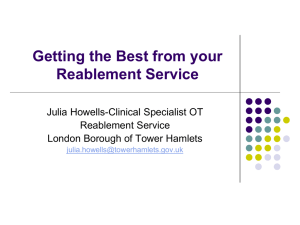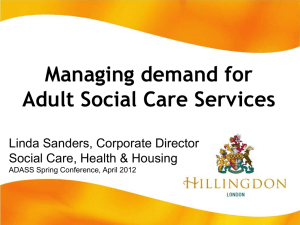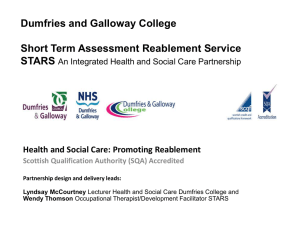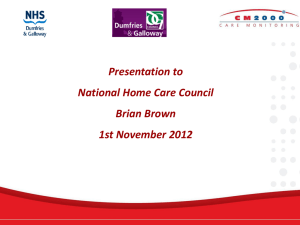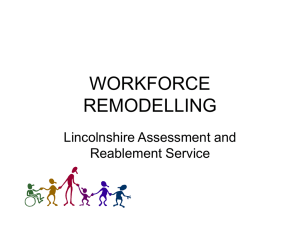Appendix 5
advertisement
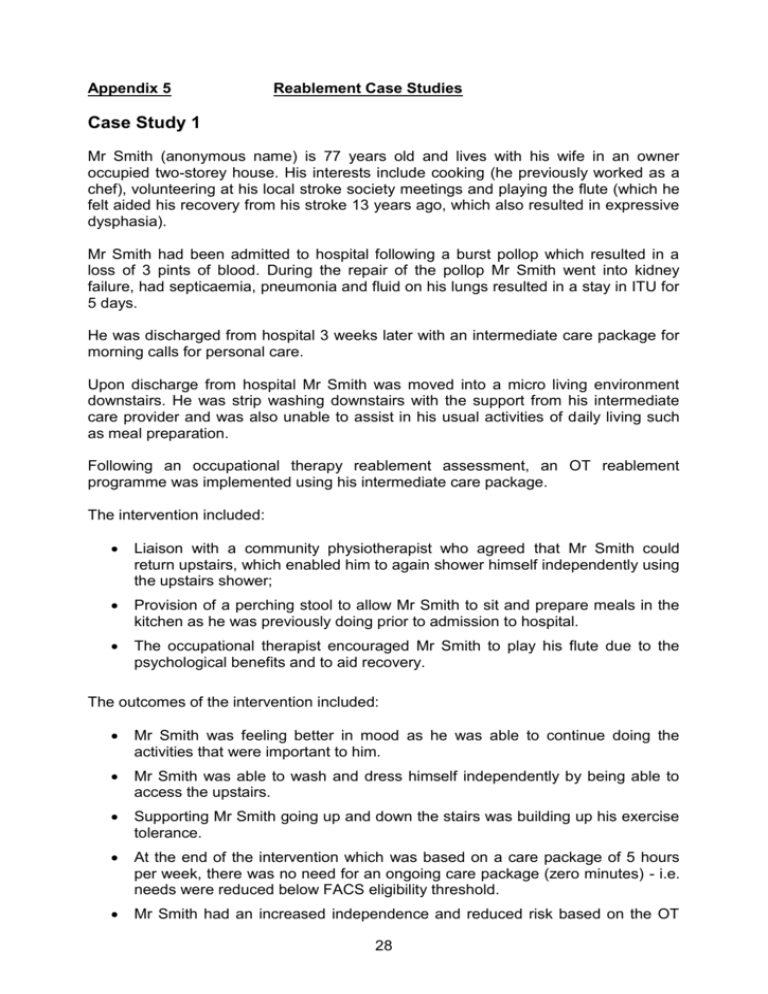
Appendix 5 Reablement Case Studies Case Study 1 Mr Smith (anonymous name) is 77 years old and lives with his wife in an owner occupied two-storey house. His interests include cooking (he previously worked as a chef), volunteering at his local stroke society meetings and playing the flute (which he felt aided his recovery from his stroke 13 years ago, which also resulted in expressive dysphasia). Mr Smith had been admitted to hospital following a burst pollop which resulted in a loss of 3 pints of blood. During the repair of the pollop Mr Smith went into kidney failure, had septicaemia, pneumonia and fluid on his lungs resulted in a stay in ITU for 5 days. He was discharged from hospital 3 weeks later with an intermediate care package for morning calls for personal care. Upon discharge from hospital Mr Smith was moved into a micro living environment downstairs. He was strip washing downstairs with the support from his intermediate care provider and was also unable to assist in his usual activities of daily living such as meal preparation. Following an occupational therapy reablement assessment, an OT reablement programme was implemented using his intermediate care package. The intervention included: Liaison with a community physiotherapist who agreed that Mr Smith could return upstairs, which enabled him to again shower himself independently using the upstairs shower; Provision of a perching stool to allow Mr Smith to sit and prepare meals in the kitchen as he was previously doing prior to admission to hospital. The occupational therapist encouraged Mr Smith to play his flute due to the psychological benefits and to aid recovery. The outcomes of the intervention included: Mr Smith was feeling better in mood as he was able to continue doing the activities that were important to him. Mr Smith was able to wash and dress himself independently by being able to access the upstairs. Supporting Mr Smith going up and down the stairs was building up his exercise tolerance. At the end of the intervention which was based on a care package of 5 hours per week, there was no need for an ongoing care package (zero minutes) - i.e. needs were reduced below FACS eligibility threshold. Mr Smith had an increased independence and reduced risk based on the OT 28 CDI scales. Case Study 2 Mrs Jones (anonymous name) is an 85-year-old woman who lives alone in a privately owned, two storey house. She has two supportive daughters but they do not live locally. Mrs Jones granddaughter lives locally and regularly supports with odd jobs around the house. Mrs Jones is a very enthusiastic woman and likes to do as much as she can for herself. She enjoys reading, watching the television and gardening. Mrs Jones was admitted to hospital with a fractured hip following a fall. She also has existing medical history of Type 2 Diabetes, Polymyalgia, Hypertension and previous T.I.A’s. Mrs Jones was discharged from hospital with a care package of 2 x 30 minute calls per day to assist with personal care. Despite this support discharge was only possible based on Mrs Jones living entirely downstairs in her house. Following a reablement assessment, interventions included: Provision of appropriate equipment to assist with bed and chair transfers, meal transport, washing and dressing. Shoes and sock techniques were practised with client until she was confident with technique. A graded homecare reablement programme was developed. The OT met with the intermediate care provider to instruct and handover the programme. The OT continued to liaise with both the client and the carer throughout programme. A referral was made to domiciliary physiotherapy to work towards Mrs Jones ultimate goal of being able to return upstairs. The OT arranged for a second stair rail to be fitted. The OT arranged for the installation of galvanised rail at the front access of the property to enable the client to go outside safely and independently. The OT also advised and supplied information on applying for pendant alarm. This would allow Mrs Jones to feel safe and confident when home alone. Further advice was given to Mrs Jones and her daughter regarding the removal of mats in house and about improving access to the back garden. Advice and information was also provided about Age UK support that is available to assist with shopping and heavy domestic tasks. The outcomes of the intervention included: Mrs Jones confidence has greatly improved, and she is now safe and independent completing personal care tasks and with transporting meals (supplied by Meals Service) from the kitchen to the living room. 29 Following a physiotherapy assessment and intervention, it was deemed safe towards the end of the reablement period for Mrs Jones to return upstairs. At the end of the intervention which was based on a care package of 7 hours per week, there was no need for an ongoing care package (zero minutes) – i.e. needs were reduced below FACS eligibility threshold. Mrs Jones had an increased independence and reduced risk based on the OT CDI scales. Mrs Jones reported being extremely pleased with the Reablement programme, which gave her the initial support she needed to improve her confidence and return to her previous level of independence. 30 Case Study 3 Ms Patel (anonymous name) is a 69 year-old woman who lives with an elderly close friend in a two-storey owner occupied property. Ms Patel was admitted hospital following dehydration and kidney failure resulting in a one off dialysis session. Other medical conditions include Gout, Osteopenia, Osteoarthritis, Diverticular disease and Hypertension. She was discharged from hospital with an intermediate care package of a morning call each day to assist with personal care; whilst a referral was also made for reablement. A reablement occupational therapist OT assessed Ms Patel’s needs and developed a reablement programme using the intermediate care package to develop independence around personal care and other domestic tasks. The OT also arranged for the provision of a perching stool and leg lifter. Ms Patel already had a bath lift in situ. Ms Patel was extremely keen to participate in activities such as cooking and ironing as these activities were part of her role within the home prior to admission. The OT encouraged Ms Patel and her friend to grade this activity together as part of the reablement programme. The OT also gave practical encouragement, for example by recommending that Ms Patel bake a cake for the royal wedding celebrations. The OT made a referral to podiatry and encouraged Ms Patel to access community transport services. The intermediate care package stopped early at 4 weeks. No further action or Care Package was required following Reablement (i.e. needs reduced below eligibility threshold). Ms Patel is now assisting with meal preparation on a daily basis and feels more occupied and satisfied with her role in the home. She is now able to transfer in and out of the bath independently (from practising with OT) and is therefore able to wash and dress independently in a morning. Ms Patel had not only increased independence and reduced risks according to the CDI scale, but also shown significant increase in both motivation and wellbeing. 31 Case Study 4 Client discharged from Croydon University Hospital (CUH) as being suitable for reablement. Client very keen to get back to her previous level of Independence. On initial assessment client was observed as having reduced standing tolerance which impacted on her standing tolerance and independence in personal care. Client demonstrated reduced ability to safely transfer on/off her toilet. Client was not independent in meal preparation, or in negotiating steps down to the toilet, either independently or safely. Client was also keen on increasing her social contact and structure to the week. After reablement intervention and support the client became independent in all aspects with the aid of equipment, also visiting a day centre, and resuming her previous level of independence, together with increased motivation. Client also finally using the bus to do her own shopping independently. 27 February 2012. 32 CASE STUDIES – REABLEMENT Name: Mr. A Age: 85 Diagnosis: Parkinson’s Disease, Stroke,Osteporosis, Peripheral vascular disease,amputation of toe,Non insulin dependent diabetic,incontinent Social history Lives alone Has a four times daily package of care Receives additional support from very good friend Ms R, who visits him regularly at home. Date admitted to CUH: 29/01/2012 Function on admission to CUH: Non weight- bearing; disorientated and confused at times; doubly incontinent. .Date Admission to AH 27/02/2012 Able to transfer with 1 Needs identified: 1) Increase mobility and exercise tolerance to prevent placement 2) Increase independence in personal care and Clients Aim and Goals To return home with previous level of care package Increase level of mobility and transfers ability Intervention: Reablement programme: Increase level of participation in attending to personal care tasks Increase level of mobility and transfers – chair, bed and toilet. Increase levels of exercise tolerance- encourage independence and safety making a hot drink. . OUTCOMES OF REABLEMENT SERVICE FACS now Substantial (may reduce further) ( on initial assessment CRITICAL) CDI before 20 after Independence increased or risk reduced but still ongoing Care Package - Maintained rather than placement Days in bed at AH – 28 days (4 weeks- to be discharged 24/02/2012) 33 CASE STUDIES – REABLEMENT Name: MS. H Age: 91 Diagnosis: Ischemic Heart disease,Depression,osteoporosis,Hemicolectomy Social history Lives alone well supported by family Function on admission to CUH: Mobilising slowly with Zimmer frame Lost confidence .Date Admission to AH 13/02/2012 (respite bed 10/02/12) Needs identified: 3) Increase confidence 4) Increase independence in personal care and Clients Aim and Goals To return home and be independent Increase confidence Intervention: Reablement programme: Increase personal care tasks Increase level of mobility and transfers – chair, bed and toilet. Increase stamina levels to make simple meal Increase confidence . OUTCOMES OF REABLEMENT SERVICE FACS was CRITICAL now moderate CDI Independence increased Care Package - none discharged home 27/02/2012 34 CASE STUDIES – REABLEMENT Name: Mr. H Age: 81 Diagnosis: Aitrial Fibulation,Vascular dementia,SOB Social history . Lives with wife independently On assessment at CUH client was transferring with two due to poorly managed pain. Thanks Date admitted to CUH Function on admission to CUH: Transferring with 2 people,in pain .Date Admission to AH 07/03/2012 Needs identified: 5) Increase mobility and transfers onto toilet,shower 6) Pain management Clients Aim and Goals To return home independently as before Intervention: Reablement programme Washing,dressing,toileting Transfers, bed,chair toilet Mobility Client started showering and making self drinks on the reablement unit independently. Client was provided with a 4"RTS and frame and shower benchA follow-up visit was completed on the 14/02/12, it was identified client would benefit from outside grab rails and a referral to the community Physio (for assessment of out door mobility) OUTCOMES OF REABLEMENT SERVICE FACS Critical now moderate CDI beforexxxx after xxxx (waiting to complete) Care Package none Days in bed at AH =5 days 35
